I left off in my last post describing the mini Village Capital program that we were in the process of piloting at Yachana High School. (Need a refresher?) After 3 weeks of intense business planning, slight confusion, intermittent frustration, and lots of learning on both ends, we selected a winning social enterprise! Of course everyone is a winner in Village Capital-ito, which is evident in the 8 sophomores who can now rattle off the importance of a value proposition and the difference between startup and overhead costs.. However Gina and Manual of “Nuevo Amanecer” (A New Day), an organic fertilizer company, came out as clear winners by receiving over 60% of first place votes by their peers and teachers.
Now I want you to think of all 16 year olds you know… think any given pair of them could come up with feasible social enterprise in 3 weeks? As I’m sure you can imagine, I was left completely jaw-dropped and speechless after listening to each group’s final presentation. True, I led them through a few workshops beforehand on business modeling and how to calculate costs over time, etc… but I can’t possibly take credit for how well each group performed. These kids have business savvy in their genes.
In general Ecuadorians are extremely entrepreneurial, occupying the 7th place for total entrepreneurship activity (TEA) in the world. However, the majority of Ecuadorian entrepreneurial activity is necessity-based (due lack of other employment options) rather than opportunity-based (starting a new venture despite available employment options). But after having witnessed such stellar business plans from students who had just learned the meaning of “profit model” and how to calculate a percentage, it’s evident that this ratio is nearing a tipping point. Watch out, world… my confidence in Ecuador’s entrepreneurial talent is stronger than ever.
As always, I’m getting ahead of myself. How did Village Capital-ito actually go down? Before turning all the Yachana students into wildly successful social entrepreneurs, we had to start with the basics. The program kicked off with a brief lesson on business modeling, followed by a giant brainstorm
of the best and the worst of the Ecuadorian Amazon; everything from Kichwa culture, fried yucca and our favorite animals to deforestation, pollution, and extreme poverty. The students later broke into teams based on mutual interests from what turned into a brain-downpour of needs and opportunities within the region. Each team was then tasked with creating a profit-generating business around their chosen social opportunity / need using the resources that are immediately available in the Amazon.
Sounds like a tall order, but these chicos rose to the challenge and then some. The social enterprises that would begin to take shape from that point forward included:
- Artesanias Regionales (Regional Handicrafts): an intermediary dedicated to providing employment and greater income to local artisans by buying their products and re-selling them in areas frequented by international visitors such as city centers, popular hotels, and tourist attractions.
- Muchshuk Kawsay (Kichwa for ‘New Life’): a socially conscious manufacturer of Balsa figurines. Balsa wood is typical to the Amazon, and Muchshuk Kawsay plans to source their material responsibly and educate customers about the different aspects of the Amazon through various figurine designs such as plants, animals, and insects.
- Nuevo Amanecer (A New Day): an organic fertilizer manufacturer that utilizes native plants and traditional knowledge to create 100% organic plant fertilizers. Their main objective is to prevent illness from chemical use and contamination of water sources.
- RRR – Reducir, Reusar, y Reciclar (Reduce, Reuse, Recycle): an educational firm that sells workshops and certification programs to the governments of rural communities and towns on how to properly dispose of recyclable material and reduce waste.
After presenting the first drafts of their business plans the following week, we began to dive deeper into the entrepreneurial process by exploring subjects such as pricing strategies and competitive advantage. A mid-point poll was taken where students had the opportunity to openly rank, applaud, and critiqued each other’s business models. During the third and final week of instruction we incorporated some basic math to forecast operating costs and earnings after 3 years. Never before have I seen so many “light bulbs” turn on at once as when each student began to realize that they could run a lucrative business that also generated a positive social return! Village Capital-ito was working…
When the day finally came to present their final business plans, an air of nervous and excitement circulated throughout the classroom. Each group had stayed up late the night before to place the finishing touches on their marketing materials, financial projections, and oral presentations (the only reason I know this is because my room is right next to the library and our inch-thick walls do little to muffle noise. Mental note for anyone who comes to work at Yachana: don’t pick the room closest to where all the late-night homework takes place). After each team had successfully presented, the students were asked to rank each enterprises from 1 – 4 based on feasibility, potential social impact, and projected financial return. In previous Village Capital programs around the world, usually 1 – 2 particpating enterprises receive the majority of peer votes. So as was expected, one enterprise from Village Capital-ito came out as the clear favorite: Nuevo Amanecer.
While I’m definitely going to consider this first go-around a success, there were lots of lessons learned along the way. For instance, Latin American culture places a high importance on hierarchies – students are below the teachers which are below the principal, etc. When I told the students that they themselves would be evaluating each other’s business plans, you would have thought I told them the sky is red. After we conquered that hurdle, even greater confusion ensued when I told them “there are no wrong answers in brainstorming.” I won’t go into too much detail, but the Ecuadorian public education system is (sadly) built around rote learning; the teacher dictates the facts and the students copy, repeat, and memorize regardless of whether or not they understand what they’re “learning.”
Needless to say, I think some of the students began to doubt my own intelligence since I refused to grade their work or feed them answers. But that’s okay. I’m happy to play the part of the crazy gringa so long as projects like RRR, Nuevo Amanecer, Muchshuk Kawsay and Artesanias Regionales keep coming up in our future Village Capital-ito programs 🙂

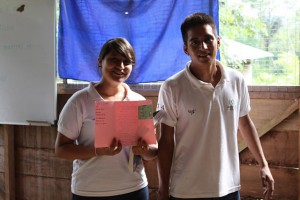

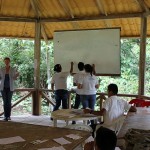
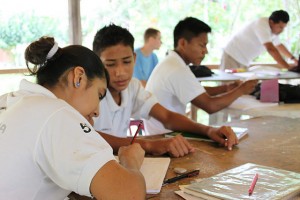

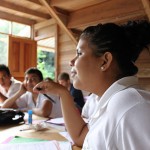
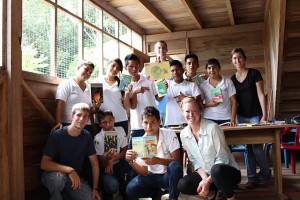


We’re loving your posts! Makes it seem like you’re not quite all that far away …